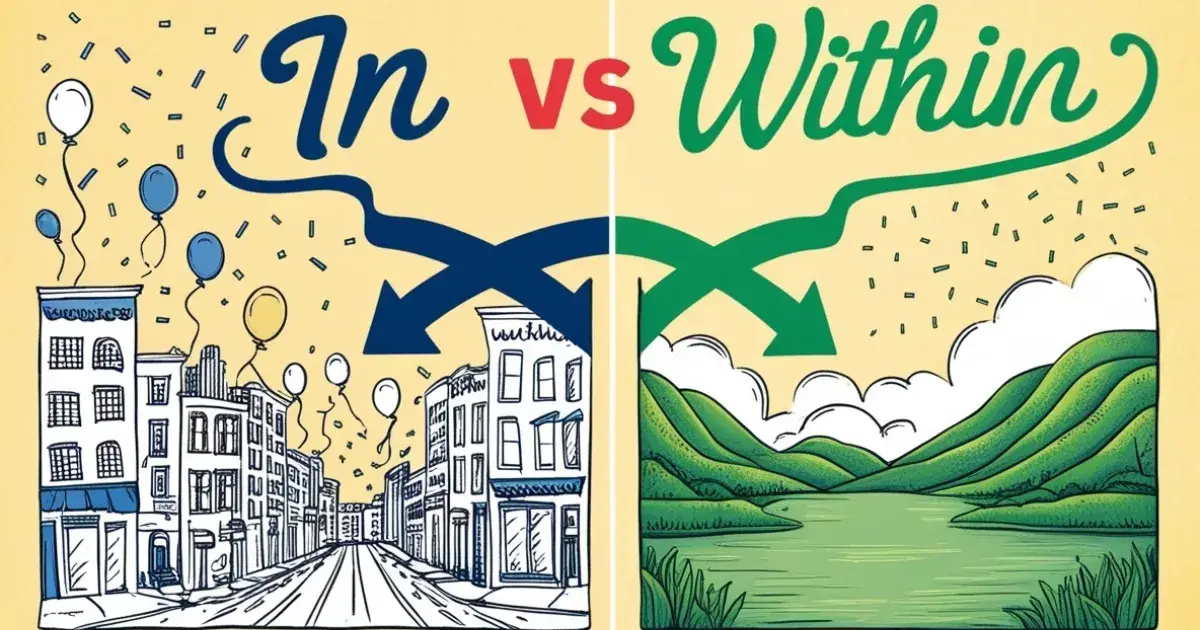When it comes to understanding “in vs within” in English grammar, many learners struggle to grasp the subtle distinctions between these two prepositions. These small words can easily confuse because they are often used in similar contexts. However, knowing the right situations to use them will help you communicate more clearly and precisely, whether in speech or writing.
This article breaks down “in vs within” by highlighting their definitions, usage, and key differences, helping you choose the right preposition every time.
Why These Terms Are Often Confused
English learners often confuse “in” and “within” because both can refer to location, time, and boundaries. While they share some commonalities, the context and level of specificity are what set them apart.
For example:
- “She is in the room.”
- “She is within the room’s walls.”
Both sentences indicate location, but “within” introduces a more specific boundary compared to “in”, which can refer to a general area.
In this article, we’ll take a deep dive into the “in vs within” debate, helping you better understand how to use them effectively in different situations.
Definitions and Usage: Understanding “In” and “Within”
Before we explore the differences, let’s clarify the definitions and basic usage of both terms.
“In” – Definition and Usage

“In” is a preposition most commonly used to describe general locations, time frames, or conditions. It is flexible and widely applicable in various contexts. “In” can refer to physical locations, abstract states, or general time frames. For example:
- Location: “She is in the kitchen.”
- Time Frame: “We will meet in the afternoon.”
- Condition/State: “He is in trouble.”
“Within” – Definition and Usage

“Within” is also a preposition, but it tends to refer to more specific boundaries or limits—whether physical, abstract, or temporal. It suggests that something exists inside a defined space or time frame. For example:
- Physical Space: “The keys are within the drawer.”
- Time Frame: “We need to finish the project within three days.”
- Abstract Boundaries: “The proposal is within the scope of the budget.”
Summary of Key Differences:
- “In” is often used for general or broad descriptions of location, time, or state.
- “Within” implies being inside specific boundaries or limits, adding a layer of precision.
Synonyms of “In” and “Within”
Synonyms for “In”:
- Inside
- Within (though “within” is more specific)
- During
- At
- On (in some contexts)
- Among
- Within the confines of
- Within the borders of
- Encased in
- Part of
Within Synonyms:
- Inside
- Inside the bounds of
- Under
- Within the limits of
- Enclosed by
- Within range of
- Within the confines of
- Within reach of
- Bound by
- Encompassed by
Comparison Table: In vs Within
Here’s a side-by-side comparison to highlight their differences more clearly:
| Aspect | In | Within |
|---|---|---|
| Definition | Refers to a general location, time, or state. | Refers to specific boundaries or limits. |
| Usage | Broad or unspecific location, time, or state. | More specific, often used for time frames, physical space, and abstract limits. |
| Common Contexts | Physical places, time periods, states. | Specific boundaries, limits, deadlines. |
| Formality | Can be used in both formal and informal settings. | Often used in more formal or precise contexts. |
| Examples | “The book is in the bag.” “We met in May.” | “The book is within the bag.” “The project must be completed within a week.” |
When to Use Each Term: In Vs Within

When to Use “In”
Use “in” when the location, time, or situation is general or non-specific. For example:
- Location: “I am in the car.”
- Time: “She will arrive in an hour.”
- Condition/State: “They are in love.”
When to Use “Within”
Use “within” when you need to describe something that exists inside a defined boundary or specific time frame. For example:
- Location: “The treasure is within the cave.”
- Time: “The task must be completed within two hours.”
- Abstract Boundaries: “The answer lies within the limits of the law.”
Everyday Usage Examples:
Here are some relatable “in vs within” examples to solidify your understanding:
Time:
- “I will complete the report in two hours.”
- “The report must be submitted within two hours.”
Location
- “She lives in the city.”
- “The evidence was found within the building.”
Abstract Boundaries
- “His opinion was in line with mine.”
- “The decision is within our power.”
Key Phrases to Understand:
In vs Within Time:
- “In” is used for general time references.
Example: “The meeting will start in an hour.” - “Within” is used when something happens within a specific time limit.
Example: “Please submit the form within 24 hours.”
Difference Between “In” and “Within” with Example:
Consider the example “The project is due in a week” (general time) versus “The project must be completed within a week” (precise deadline).
Is “Within” a Preposition?
Yes, “within” is a preposition, just like “in”. It connects a noun or pronoun to other parts of a sentence, indicating location, time, or boundaries. The difference is that “within” often refers to something more specific, whether in terms of physical space, time, or limits.
Can You Start a Sentence with “Within”?
Yes, you can start a sentence with “within”. It is often used in more formal contexts to indicate a condition or time frame, especially when emphasizing boundaries or limits.
Example:
“Within the constraints of the budget, we managed to complete the project.”
Conclusion: Key Differences and Practical Applications
To sum it up, the difference between “in” and “within” primarily comes down to specificity and boundaries. While “in” is more general, “within” often denotes something more defined or limited. By understanding these distinctions, you can use these prepositions more accurately in your writing and speech.
Remember the following tips:
- Use “in” for general, non-specific references to time, location, and condition.
- Use “within” when referring to something confined by specific limits, such as a time frame, physical boundary, or set of rules.
Armed with this understanding, you’ll be able to navigate the fine line between “in vs within” with ease. Now that you have a clearer understanding of “in vs within”, try practicing with the following in vs within worksheet to reinforce the concepts. Also, don’t forget to test yourself with in vs within exercises or review more in vs within examples to solidify your knowledge!

This author is a passionate linguist and grammar enthusiast, dedicated to helping individuals master the art of language. With years of experience in teaching and editing, she brings clarity and precision to every sentence. Tina’s mission is to empower writers of all levels to express themselves with confidence and excellence.

